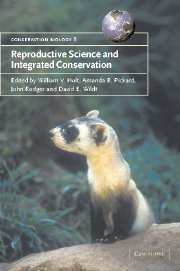Book contents
- Frontmatter
- Contents
- List of contributors
- Foreword
- Part I Introduction
- 1 Toward more effective reproductive science for conservation
- Part II Reproduction and population viability
- Part III Reproductive techniques for conservation management
- Part IV Integrated conservation management
- Part V Reproduction science in non-mammalian species
- Part VI Conclusions
- Index
- References
1 - Toward more effective reproductive science for conservation
Published online by Cambridge University Press: 21 January 2010
- Frontmatter
- Contents
- List of contributors
- Foreword
- Part I Introduction
- 1 Toward more effective reproductive science for conservation
- Part II Reproduction and population viability
- Part III Reproductive techniques for conservation management
- Part IV Integrated conservation management
- Part V Reproduction science in non-mammalian species
- Part VI Conclusions
- Index
- References
Summary
INTRODUCTION
Reproduction is the foundation on which a species survives, thrives or, failing this, becomes extinct. Therefore, the study of reproduction is fundamental to conserving species, populations and, indirectly, the vitality of entire ecosystems. Historically, reproductive biology research has been directed at easy-to-study domesticated livestock, laboratory animals and humans. The general approach has been one of scholarly, systematic studies that emphasised understanding mechanisms, sometimes seemingly arcane information that had (or did not have) practical application (e.g. making livestock more reproductively efficient or combating human infertility).
Reproductive biologists involved with wildlife also conduct scholarly research, often in a challenging environment. These explorers are hampered by limited resources and the practical difficulties of accessing rare, intractable and sometimes dangerous study specimens. Nonetheless, there has been progress in the study of the reproductive biology of wildlife, including endangered species. Perhaps the most important lesson learned during the past quarter-century has been that species vary remarkably – and wondrously – in precisely how they reproduce. The mechanisms that regulate reproductive success in the cow are quite different from those that control reproduction in the elephant, dolphin, snake, shark, parrot or frog. This reproductive machinery varies significantly even within families, species positioned in the same branches of the evolutionary tree (Wildt et al., 1992, 1995). Therefore, for example, mechanisms controlling reproduction in the cheetah are likely to be different from those of a lion or snow leopard. Understanding these species-specific strategies has become a top priority.
- Type
- Chapter
- Information
- Reproductive Science and Integrated Conservation , pp. 2 - 20Publisher: Cambridge University PressPrint publication year: 2002
References
- 4
- Cited by

